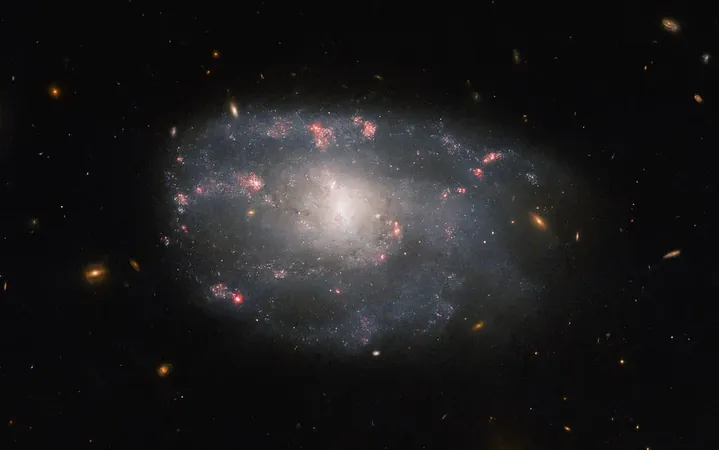
Unveiling the Cosmic Conveyor Belt: How Elements Flow In and Out of Galaxies
2025-01-17
Author: John Tan
In a groundbreaking revelation about the evolving nature of galaxies, new research sheds light on the mysterious circulation of elements in and out of these colossal cosmic entities. While star-forming galaxies, including our Milky Way, start their existence with active star production, this vigorous activity doesn't last indefinitely. Eventually, these galaxies experience a decline in their star-formation rate (SFR), and scientists are now beginning to understand the mechanics behind this slowdown.
Recent findings published on December 27, 2024, in The Astrophysical Journal Letters, indicate that massive currents within a galaxy, likened to a cosmic conveyor belt, play a crucial role in this phenomenon. These currents, residing in a structure known as the circumgalactic medium, facilitate the movement of elements, ultimately influencing how new stars and planets are formed over billions of years.
A Deep Dive into Galactic Mysteries
Led by researcher Samantha Garza from the University of Washington in Seattle, a team of astronomers conducted an intricate analysis of light from nine distant quasars filtering through the circumgalactic medium of eleven star-forming galaxies. Using the Cosmic Origins Spectrograph aboard the Hubble Space Telescope, they observed how the light was altered in the presence of these massive reservoirs. Their observations revealed that the circumgalactic medium contains hot gases rich in oxygen and carbon, vital components for future stellar creations.
Remarkably, some carbon atoms were found traveling as far as 400,000 light-years from their home galaxies—more than four times the size of the Milky Way’s bright disk, which spans 100,000 light-years. “The same carbon in our bodies most likely spent a significant amount of time outside of the galaxy,” noted Jessica Werk, a co-author of the study, highlighting the cosmic connection that exists between us and the universe.
Galactic Exchange: A Metaphorical Train Station
Garza effectively compared the circumgalactic medium to a bustling train station, where elements are constantly exchanged. Stars eject heavy elements into this medium through supernova explosions, and over time, these elements may be reabsorbed into new stars, continuing the cycle of chemical enrichment and star formation.
Previous studies dating back to 2011 established that star-forming galaxies are surrounded by a circumgalactic medium teeming with ionized oxygen. In contrast, galaxies stagnant in star production tend to have diminished amounts of this critical gas. The latest study extends this understanding by revealing that the circumgalactic medium is not only a reservoir of hot gases but also contains low-temperature materials, including carbon atoms. This ongoing exchange plays a vital role in recycling star materials, crucial for nourishing the next generation of celestial bodies.
Understanding the Slowdown: A Cosmic Puzzle
By mapping out this recycling process, astronomers can gain insights into what ultimately causes galaxies to slow down or cease star formation altogether. The breakdown of circulation patterns in the circumgalactic medium could starve galaxies of the essential materials necessary for building new stars and planets.
Future research will undoubtedly delve deeper into the chemical composition of currents flowing in and out of the circumgalactic medium, exploring differences between active star-forming galaxies and their dormant counterparts. Early indications suggest a direct correlation between the star-formation rates of galaxies and the expanse of their circumgalactic reservoirs.
These innovative studies are reshaping our understanding of galaxy evolution and illuminating the paths taken by the very materials that constitute Earth and all living beings. As we continue to unravel these cosmic mysteries, the story of our universe becomes increasingly intertwined with our own existence. Stay tuned for more celestial revelations that could redefine our place in the cosmos!




 Brasil (PT)
Brasil (PT)
 Canada (EN)
Canada (EN)
 Chile (ES)
Chile (ES)
 Česko (CS)
Česko (CS)
 대한민국 (KO)
대한민국 (KO)
 España (ES)
España (ES)
 France (FR)
France (FR)
 Hong Kong (EN)
Hong Kong (EN)
 Italia (IT)
Italia (IT)
 日本 (JA)
日本 (JA)
 Magyarország (HU)
Magyarország (HU)
 Norge (NO)
Norge (NO)
 Polska (PL)
Polska (PL)
 Schweiz (DE)
Schweiz (DE)
 Singapore (EN)
Singapore (EN)
 Sverige (SV)
Sverige (SV)
 Suomi (FI)
Suomi (FI)
 Türkiye (TR)
Türkiye (TR)
 الإمارات العربية المتحدة (AR)
الإمارات العربية المتحدة (AR)